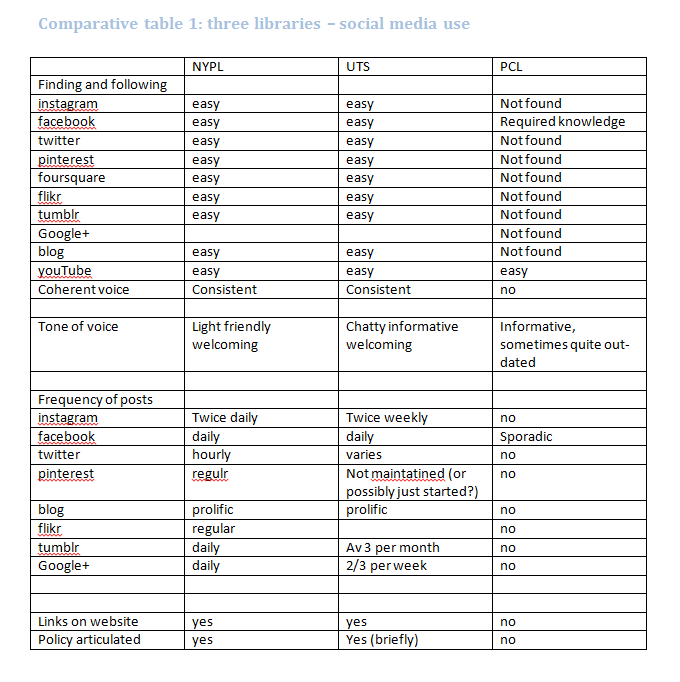Select
three (3) libraries of your choice that use social networking to meet their
goals. Develop a comparative table which documents how each of the
libraries use social networking tools to support information service provision,
educational programs, conduct business etc.
Based on this
comparison (and in no more than 350 words) develop your own list of “Reasons
why libraries should be on social media”, and draw upon aspects of these three
libraries to illustrate each point.
I
began this exercise by comparing two libraries I already follow on social media,
New York Public Library (NYPL), UTS Library (University of Technology Sydney),
and for interest-sake my local public library Penrith City Library (PCL). What
I discovered about PCL is the stuff of another blog post however, as there is
no clear evidence that PCL uses social networking to meet their goals (see
Table 1), I changed tack and added the State Library of NSW (SL NSW) into the mix
to develop Table 2 and the following three reasons libraries should be on
social media.
1. Self-preservation
In the age of the
GFC, torrenting, and google, libraries are not the only place readers can get their
books for free, they are no longer the gatekeepers of knowledge so they must
prove their worth in terms of both capital investment and user engagement.
Terra Dankowski (2013) points to the “more than 80 facebbok pages and 60
Twitter accounts representing the 90 branches” (p. 34) as evidence that NYPL is
an exemplary model for using social media to maintain viability in the
information society. Johannes Neuer states NYPL’s goals for social media as “brand
awareness, increased traffic and creating community” (quoted in Dankowski, 2013, p.34.) citing a 35% increase in membership as a response to a sustained Twitter campaign as proof of success.
2. Innovative service
While there is still a place for the traditional buildings with books, “libraries
face challenges to innovate their service to stay competitive” (Scupola & Nicholajsen, 2013, p. 27). Users can now chose where they’ll get their information/entertainment from a huge array of options and they
are doing it remotely – if libraries don’t have a social media presence users
can and will just ignore one service in preference for another. The Social
Media page of the UTS website tells users they can “find us” on facebook, join
the conversation on Twitter, watch tutorials online, and engage with the story. UTS has a fun and engaging presence as demonstrated by their Twitter feed. This moves the library on from the traditional service and offers an attractive way for students to engage with the service.
3. Create community
Public libraries have a long history of building community, as providers
of ‘free’ public services (supported by rate-payers), and as repositories of
local history. SL NSW stresses this in its Strategic framework and supports these ideals through social media engagement, articulating
this through a Social Media Policy that states “social media can be used to
enhance communication, collaboration and information exchange” (State Library NSW, 2012, p. 10). SL NSW’s
facebook page is a great example of leveraging social media to create
community, with a 4.4 star rating it’s clear that users approve, there is
strong support for local events, such as the recent Sydney bushfires, and a
focus on marketing library activities.
Dankowski, T. (2013). How libraries are using socila media: Expanding online toolkits to promote
advocacy. American Libraries, 44(5), 38-41.
Scupola, A., & Nicolajsen, H. W. (2013). Using social media for service innovations: Challenges
and pitfall. International Journal of E-Business research, 9(3), 27-37.



No comments:
Post a Comment